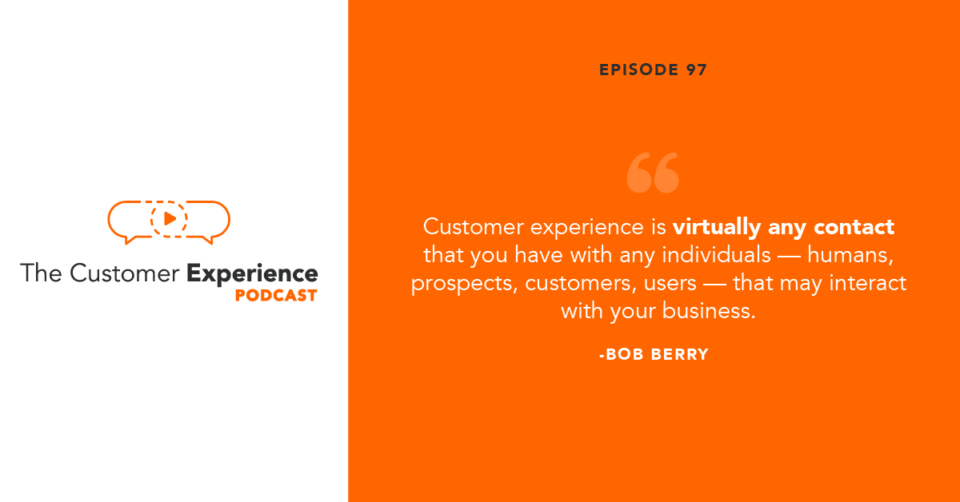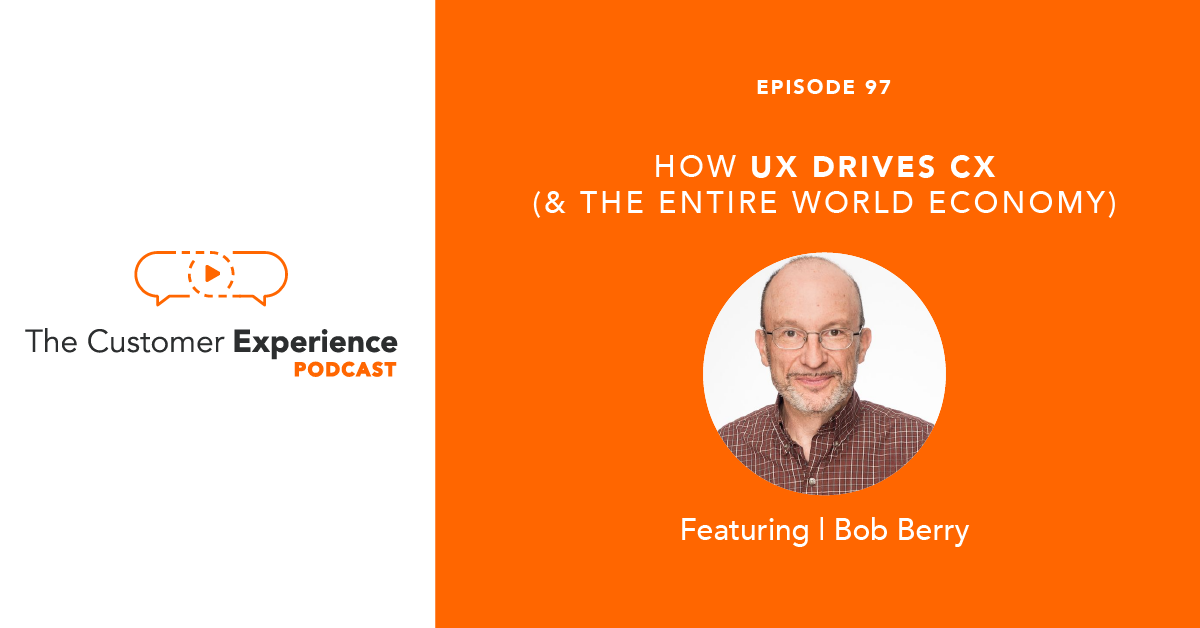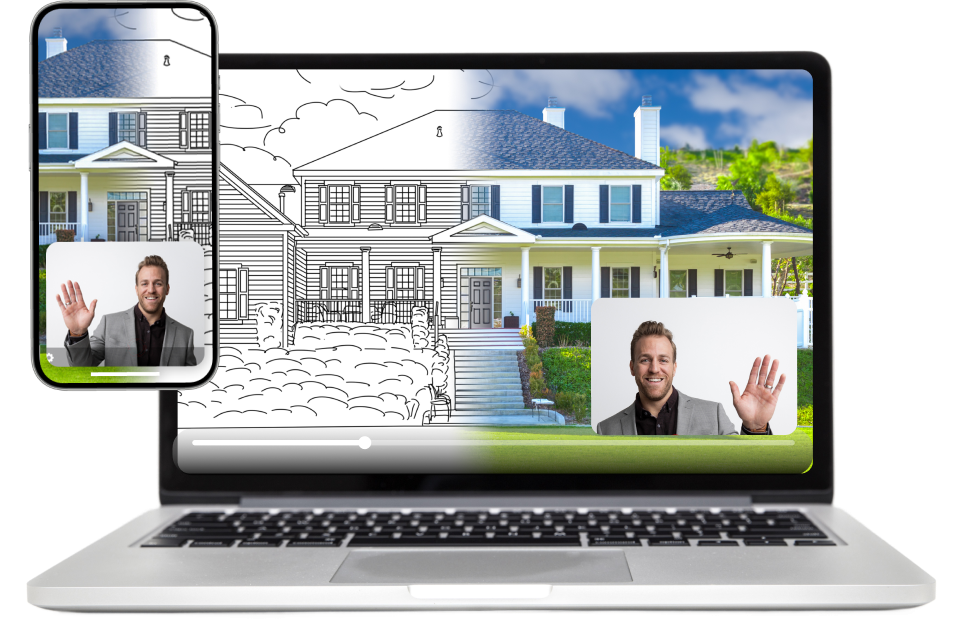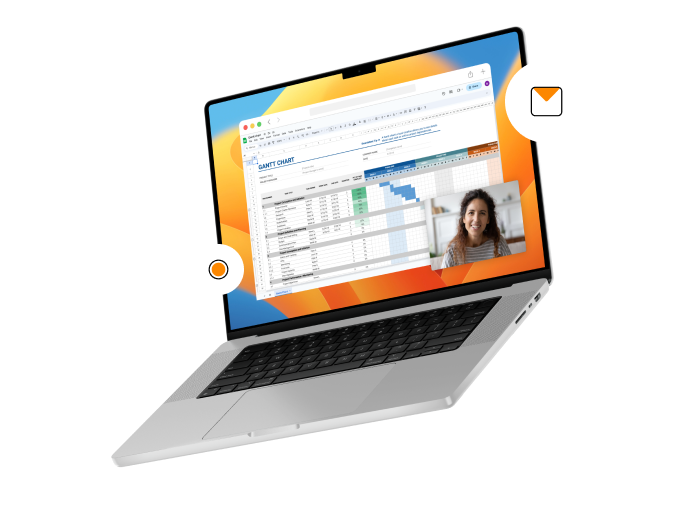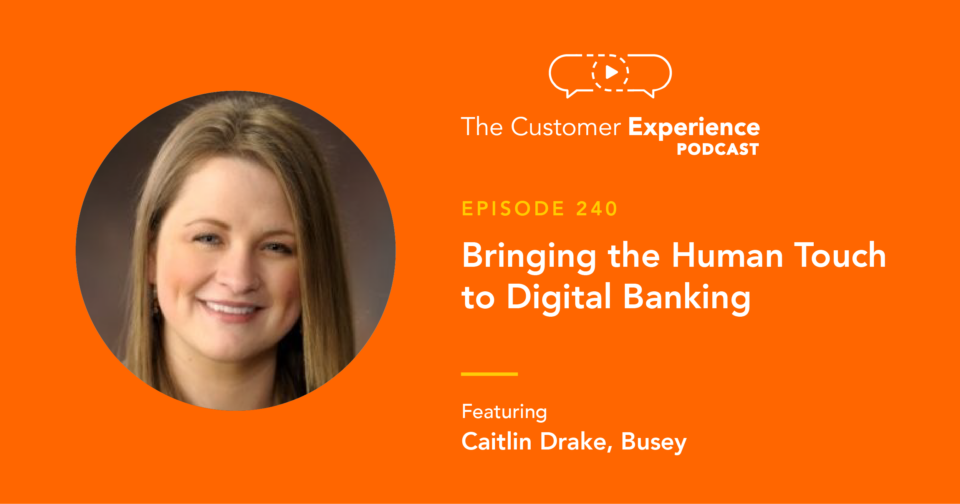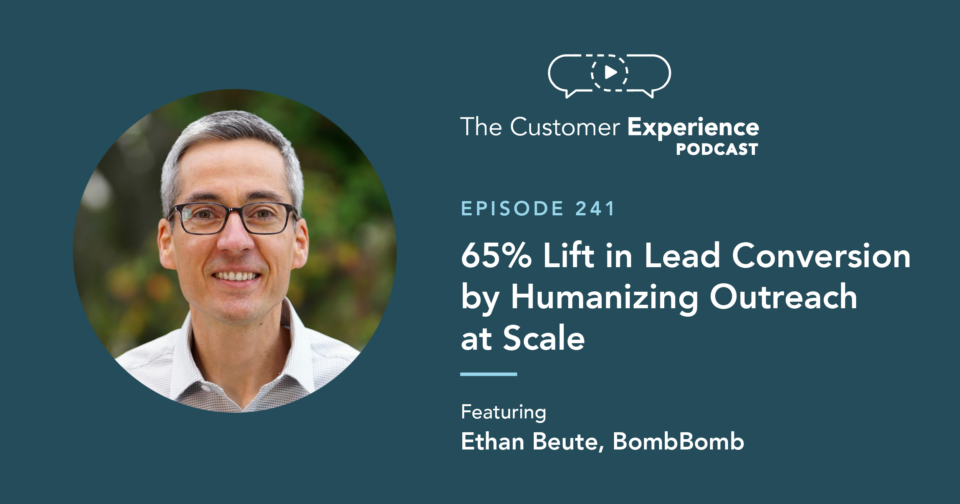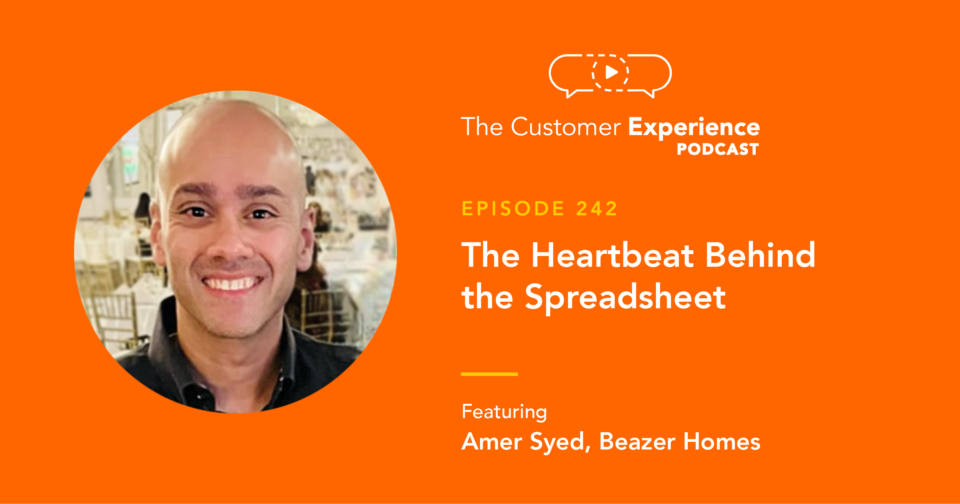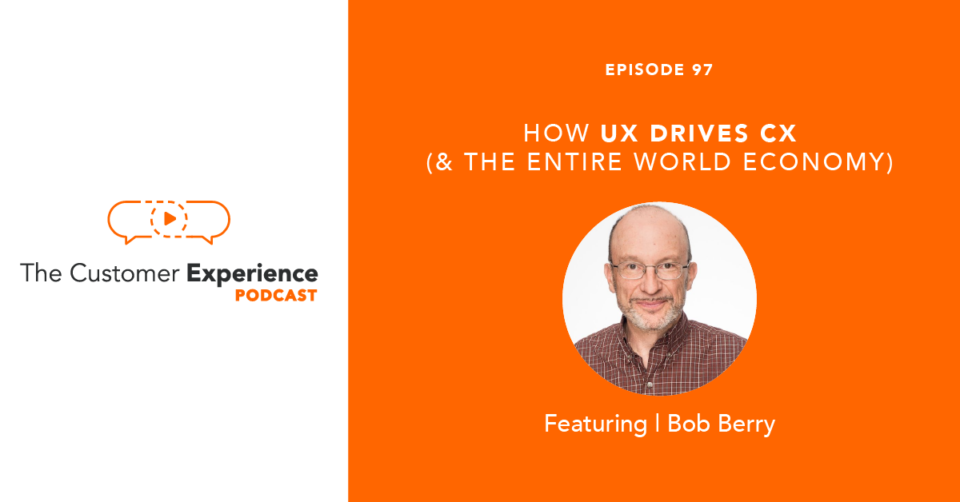
Listen to “97. How UX Drives CX (& the Entire World Economy) w/ Bob Berry” on Spreaker.
Apple Podcasts | Google Podcasts | Stitcher | Spotify
Any time someone interacts with a screen or an interface, a user experience (UX) is delivered. And within the past 20 years, user experience has completely recontextualized customer experience (CX) because so many of the touchpoints humans have with businesses are digital.
Arguably, UX drives the world economy because of how prevalent virtual interfaces are today. So when we contextualize UX in terms of CX, we want to understand the individual human user, as well as their personal and technological experiences. That’s a tall, tall order.
Today’s guest on The Customer Experience Podcast, Bob Berry, is a UX expert who’s done work for Google, Facebook, Amazon, Apple, Microsoft, FedEx, PayPayl, and many others.
He studies digital transformation, user experience, and brands — which is all the more imperative now that COVID-19 has precipitated our need for going almost completely contactless.
Bob, Principal User Experience Researcher at AnswerLab, researches and designs human-computer interactions. At AnswerLab, Bob leads UX research for world-class companies and at The Human-Computer MasterMind Academy, Bob is a speaker, author, researcher, and presenter.
In this episode, you’ll hear Bob and I discuss…
• How UX drives the world economy
• What UX shares with Sales and Marketing
• Who represents the gold standard in UX
• What cautions to take into account with changing data sets
• How the emerging trend in favor of data privacy affects you and your customers
How UX Drives CX (and the Entire World Economy)
Hear the entire conversation with Bob Berry of AnswerLab right here:
Listen to “97. How UX Drives CX (& the Entire World Economy) w/ Bob Berry” on Spreaker.
Hear this episode of The Customer Experience Podcast – and many others – by subscribing to in:
Click a link above to see the podcast in your preferred player. Then click to leave a rating for the show. That click to rate is extremely helpful to the show.
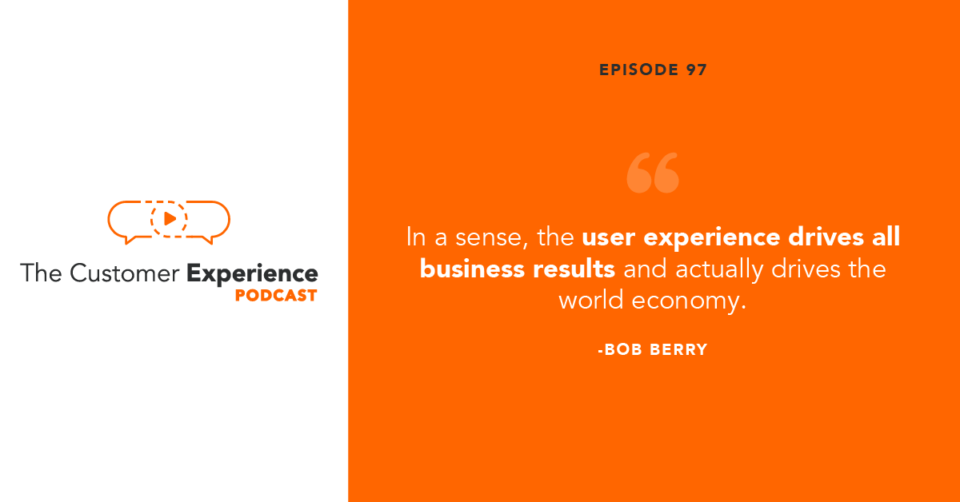
Full Transcript: 4 Steps to Better Storytelling
Ethan Beute:
Digital, virtual, contactless or contact-free, no matter how you describe it, no matter what business you’re in, your customer experience is more physically hands off today than it was at the start of 2020. And it’s going to stay that way for the foreseeable future. So today we’re talking about how to create exceptional online experiences that drive customer engagement and produce results. And we’re doing it with a gentleman who researches and designs human-computer interactions, and who’s focused on customer experience, user experience, and learning experience. He spent years inside companies like Hewlett Packard, Agilent Technologies, and Deluxe Corporation. He’s currently a speaker, author, researcher, and presenter with the Human-Computer MasterMind Academy at ItsTheUsers.com. He also serves as Principal User Experience Researcher with AnswerLab and is leading in-depth research for Google, Amazon, Cisco, and other world-class companies. Bob Berry, welcome to The Customer Experience Podcast.
Bob Berry:
Thanks, Ethan. Glad to be here. Looking forward to this.
Ethan Beute:
Yeah, me too. We haven’t done. I’m hoping we get maybe a little bit technical or we really operate at that human-machine intersection point. It comes up thematically, but certainly not with the depth of exposure and knowledge that you have to that. But before we get going in earnest, AnswerLab is based in San Francisco, but you’re here with me, not physically, but you’re here with me on Zoom in Colorado Springs and you’ve been here for years. So how did you land here and what do you love about being here?
Bob Berry:
Well, I actually grew up in Colorado. I’m not originally from Colorado, but I’ve spent the majority of my life here. So as you mentioned, I worked for Hewlett Packard. And Agilent still has that facility out on Garden of the Gods Rd. So that’s the… I worked there for 15 years back in the days when Bill Hewlett and Dave Packard were still alive. So I’ve always enjoyed Colorado. I love the outdoor life. I love the business opportunities here. So Colorado Springs and the Front Range have been home for most of my years.
Ethan Beute:
Awesome. And it is a much different town than it was even before I arrived, which was about 13 years ago. So I can’t imagine the amount of change you’ve seen here locally.
Bob Berry:
Yeah, it has changed a lot. Fortunately, a lot of the beautiful mountain areas and wilderness and everything that’s West of here hasn’t changed that much. So we still get a chance to get away. And especially these days when we’re looking for opportunities for extreme social distancing, those places are still available to us.
Ethan Beute:
Absolutely. I was fortunate to be able to get out with my son a couple of times last week and it’s awesome. I love how close everything is to Colorado Springs with regard to wilderness outdoors, et cetera. So you do a lot of work with experience. We’ll start with your definition or your thoughts or characteristics of customer experience in particular. When I say customer experience, what does that mean to you, Bob?
Bob Berry:
I interpret that pretty broadly. So I interpret customer experience as virtually any contact that you have with any individuals, humans, prospects, customers, users that may interact with your business. And we tend to think of this whole concept of omnichannel, which is really looking holistically at all of the ways that you might interact with or touch a customer. That certainly can include many different ways online, but it can also include a phone, it can include face to face contact, it can include printed materials, PR. It doesn’t really leave anything out when it comes to your interactions and how you might make offers to, or serve or support customers at any point through the product or customer life cycle.
Ethan Beute:
Great definition, covers a lot of the themes that we talk about here. In particular, the one that you really hit in a variety of different ways is that it’s every single touchpoint, human, analog, digital, et cetera. And it’s so important. That’s the reason we host this show, is to talk about how if so many different people inside your organization are involved in creating and delivering these various aspects of the experience, how do we do it in a way that’s intentional and aligned? And so you also are a user experience expert. You’ve done a lot of work and learning experience, talk about these other experiences, and maybe where they intersect with or diverge from customer experience.
Bob Berry:
So I guess it’s difficult to come up with a lot of really comprehensive definitions because this can vary a lot from one type of business to another, from one type of customer to another, one type of system or interactive platform or interface to another. But in general, user experience tends to go deeper. It probably does not cover as many of those touchpoints that we discussed when we were defining customer experience. So for example, it may not cover as much around what you might consider customer service or support, although there may be elements of that as well. The user experience really talks a lot more about the fine points and the particulars of how a human being interacts with some kind of interactive system, or platform, or app, or a website, or device.
Bob Berry:
And that human-computer interaction, that HCI that we often refer to, there’s a lot of science that goes into creating those types of interactions and a lot of science that goes into evaluating and optimizing those interactions. We work on a basic premise that all business results, and I challenge anyone to think of one that doesn’t fall within this definition, all business results are individuals making specific choices within the user experiences we provide them. And in a sense, the user experience then drives all business results and actually drives the world economy, because all of those individual decisions and reactions and choices and responses from users or customers add up to all the business outcomes that we can imagine, and therefore what drives that world economy. So experience and how somebody interacts with those virtual interfaces is really at the center of so much of what we’re trying to do and ways that we’re trying to serve and influence our customers and our prospects.
Ethan Beute:
Do you separate at all or are they all bundled together? And if you do separate them, is there any hierarchy with regard to the human feelings or thoughts or behaviors? Do you separate those elements? Do you study them independently? And what is the relationship between those?
Bob Berry:
Yeah, I’m glad you asked that. In user experience research, and there’s certainly elements of this in customer experience as well, in user experience research we really create a context around that virtual interaction around those human-computer interactions. And that context is really understanding the individual, understanding their narrative. So we talk about things like ethnographies, we talk about journeys, we talk about personas. And that really, all that happens before we actually get into those virtual interactions. We want to understand these individuals, their lives, whether it’s a business or a personal context, what motivates them, what are their needs, what kind of outcomes are they looking for? What is their level of technical capability? How savvy are they about technology? What’s their economic status?
Bob Berry:
So there’s a whole lot of things we want to learn about all those individuals that puts that virtual interaction, that interface in a much more relevant context when we try to interact with them and serve them and do something useful for them. That context is really critical to understanding the experience because you can’t always separate their interactive experience with your app or your website from the larger context of their lives, and what’s important to them and what they’re trying to accomplish.
Ethan Beute:
Right. It’s the whole picture or as much of the picture as you can get. It’s so much more useful in terms of making decisions that are going to be helpful for them. Do you work, I’m going to go one follow up there. When you start talking about ethnographies and journeys and personas you’re obviously talking about things that sales and marketing likes to talk about. Have you found from an organizational standpoint, from a workflow standpoint, from a project development and management standpoint, does this work? It seems like it could, should, would intersect very directly with what sales and marketing is doing in terms of who they’re bringing to the experience. Do you find that that tends to be the case?
Bob Berry:
Absolutely. And a lot of the work that I do with a lot of the brands that you mentioned, with Google, Facebook, Amazon, a lot of the work we do with them is in fact evaluating and guiding people through the front end experiences, how do people interact with those companies offerings, their marketing programs, their online catalogs, their offers, their social media. So the whole upfront process when they’re still in the prospect stage, when they’re still in the learning and discovering and shopping stage, in many cases may actually focus more on that than we do the actual transaction or what happens after the transaction, because that part of it is so essential to those companies and those businesses being successful, and those users and those customers finding what they need.
Ethan Beute:
You’ve already driven by this. I always like to ask something like this for folks who aren’t familiar. Can you tell us a little bit about AnswerLab? Who is your ideal customer? Is it these giant world-class brands or is it more than that? Who’s your ideal customer and what specifically do you solve for them?
Bob Berry:
So we do a lot of the kind of research we’ve been talking about for those brands and a lot of major brands in high tech, in automotive, in pharmaceuticals and financial, in just about any of the major industrial categories or customer segments that you can imagine. And these are companies that rely heavily on the virtual platforms and the virtual tools and the virtual offerings that they provide to the marketplace. And again, that can include everything from the online catalogs that they provide, the shopping experiences, the social media programs that they run, all of the ways that they actually do business with customers and transact orders. And then in many cases how they support those customers and how they maintain ongoing relationships with them once they become customers. And so these are companies that for them, user experience and customer experience is not an event, it’s an ongoing process. It’s built into their culture.
Bob Berry:
You look at a company like Amazon, and they’ve been doing this from the very beginning, and the user experience that they have is often pointed to as sort of the gold standard. And it’s one that obviously has served them very well. And if you look at their recent performance and everything that’s happened over the last few months, and how successful they’ve been in providing all of the products that we don’t go out and shop for anymore, clearly they have an interface that billions of people are familiar with and comfortable with and use on a regular basis. And has really become a critical part of the world we live in today. So we help them optimize those experiences, so people at all levels can make sense out of those, can get what they need, and can be successful in getting the products and services that are required for them to be successful.
Ethan Beute:
Awesome. It’s a great example. And I think almost all of us listening should be able to relate to that one. For me, I think the most dangerous thing they’ve done is the buy now button, particularly in mobile. It’s just so easy to hit it on purpose or on accident. Like here we go, it’s just that easy. Before we go one step further, and you’re right there into how things are changing maybe for some other businesses. Amazon had this built-in from day one, but other people are needing to figure out how do we turn maybe the physical into the virtual or the things where we might hand off physically to contactless operations and getting into that.
Ethan Beute:
What part of the organization are you typically plugging into when you come in to do this type of research? What I’m thinking about now is a listener who might be saying, “Gosh, I don’t know that I can hire AnswerLab because we’re a much, much smaller organization and we don’t have it figured out yet. And we don’t even know what research questions to ask.” But we should be doing this type of work, whether we do it internally or we hire it out, where do you usually plug into the organization?
Bob Berry:
We plug into a lot of different places. And actually I’m glad you asked the question about the smaller organization. So in addition to AnswerLab, as you mentioned at the beginning, I also run this operation called ItsTheUsers.com, which is the Human-Computer Mastermind Academy. The mission there is to help smaller companies, entrepreneurs, professionals get introduced to this world of understanding their users, really understanding the context and the narrative, and figuring out how to create the right kinds of experiences that are going to help their businesses succeed and also help their customers and their end-users succeed. And so we do a lot of stuff for free. We do a lot of stuff at very low cost. That’s on a whole different scale economically than what a lot of those big brands do. So we provide that as well.
Bob Berry:
To answer your question about where do you plug in, it used to be that user experience, customer experience was sort of a side operation. It might be attached somewhere in marketing, it might be attached somewhere in the IT department, or some cases it might be even part of the sales operation. Right now in many of these companies, it’s deeply embedded in the culture. And from top leadership on down, the boards of directors, the CEOs, the CIOs they all pay very close attention to this. And the amount of funding that they provide is pretty substantial to continue this type of research and this kind of optimization ongoing. So in many cases, we may be talking to organizations that are running large marketing programs that are trying to promote and merchandise products and try to influence customers and transact business online or offline as well.
Bob Berry:
We may also plug into the parts of the organization that are specifically responsible for web and e-commerce and virtual platforms. Some companies are all about virtual, their whole operation, their whole mission is based on interactive virtual platforms. And so we may plug into various parts of the organization depending on what aspect of promotion and outbound or inbound marketing. They probably have a social media team. They probably have a content development team. They probably have online catalogs that they’re working with product merchandising. So all of these are areas that we might similarly plug into, or we might plug into multiple aspects of those as well. But in many cases, a lot of this is recognized and funded and tracked very closely from the top of the organization in the more successful companies.
Ethan Beute:
It’s fantastic. And I am going to go out on a limb, I’m sure you’ll go out there with me if you have to and say these are the companies that are built to last. People that have that embedded in the culture. So let’s get really specific to all the changes that were forced upon basically every business that exists for the most part. And of course, some more than others, because some relied so much more heavily on physical contact and physical interaction, human to human interaction, not just via Zoom or via phone or whatever, but actual human to human interactions. At the risk of stating the obvious, can you start at the beginning and maybe talk about the transformations that you’ve been seeing, or maybe the accelerated rates of transformation that you’re seeing in reaction to the pandemic?
Bob Berry:
Well, the big driver, of course, is the need to go contactless. So there’s still a tremendous amount of conflicting science out there about exactly how this virus is transmitted. And in the last few weeks, in many parts of the country, the numbers of new cases has gone up dramatically, yet we still don’t really understand how this is transmitted. My wife and I have five kids that are scattered throughout the West, and we’re debating going on a road trip in a few weeks to go visit them. But we really, it’s an ongoing research and discussion process about, is this really feasible? And what are the risks that we’re taking, and what are the things we should do and shouldn’t do? On any given day if you follow the news, you get conflicting stories and data and science and recommendations.
Bob Berry:
So it’s about contactless. And in so many ways, not just businesses, but organizations of all types have been forced to figure out how to do what they do without doing any physical contact or minimizing physical contact. I’d rattle off a number of examples, just all the companies and business operations and their employees that have simply gone home to work, they’ve gone remote. And so here we are on Zoom and the use of Zoom has exploded. So telework in and of itself has been a major transformation. Some of that’s not going to go back, it’s going to stay where people are going to continue to do that. You look at education at all levels, from preschool all the way up to postgraduate in college, it’s completely changed. And honestly, we haven’t figured that out. If you look, the jury is still out on how to make that work.
Bob Berry:
And with everybody pulling students out of classes at all levels back in March, and then trying to cope from March until now, I think that the general consensus is we failed. We haven’t figured it out. We have a long way to go. Health and medicine have changed dramatically. So I’m trying to catch up on some of my doctor’s appointments that I’ve been procrastinating on the last few months. And a lot of these now we’re doing virtually, we’re doing through Zoom meeting, we’re doing through sharing records, online, scheduling things and trying to do as much as possible. Simple examples in small businesses, the restaurants that are allowing you to order online and pick up at the curb.
Bob Berry:
There’s another example here in Colorado Springs of a construction company that has gone totally video, where they will show you how to do video with your phone of the space in your home that you want to have remodeled, and you send them the video. They’ll come back to you with simulations of what that space would look like with new materials, with a redesign. Then they’ll come back and they’ll show you a simulation of how they’re actually going to come in and do the work and how they’re going to maintain social distance. And I’ve heard other examples of tailors that have figured out how to do measurements using apps, and how to measure your body and send them your body measurements for a new suit without having anything… We could go on and on and on about all these examples of all the ways that we’re figuring out how to do this. So it’s pervasive. A lot of it is very creative. And as they say, necessity is the mother of invention, and there’s a lot of new stuff being invented.
Ethan Beute:
Yeah, I love it. And some of these examples, for example, the one about the tailor where you use the app and it takes your measurements and you get a custom cut suit for like five or 600 bucks. That’s one of those where it’s an idea whose time has come, and then there’s this other camp where it’s we’ve been doing this for a long time successfully or unsuccessfully, how do we adapt? And I think that’s the majority of a lot of them. And to your point, I mean, we’ve bagged a couple of trips to Arizona. We have family down there, and my son is looking at a couple of schools in Arizona. We’ve canceled two of those trips.
Ethan Beute:
So I can imagine your thoughts around, is this good or not? And the science is very, very challenging. Also, a lot of it is politicized, which makes it more confusing. And there’s a great deal of challenge here for, I know that you’re talking with a lot of folks, you’re doing a lot of presentations and engagements like this one we’re enjoying right now, what are a couple of things that people have found surprising or low hanging fruit or missed opportunities? What are some things that you’re seeing that might be practical from a takeaway standpoint, for someone listening to improve what they’re doing?
Ethan Beute:
For example, specific to your touchless, I just released an episode, by the time this releases it will have released a week or two before, with a gentleman who works at a company, Michael Ashford works at this company called The Receptionist. They’re based up in Denver, coincidentally. And they provide those iPads where people can punch in and then it alerts the person you’re coming to visit at the office and all of this. And just to remove the idea that someone has to touch an iPad, they’re adapting it so that it talks to your mobile device. So you can check in on your own phone via the rest of this infrastructure. And so anyway, I would assume that you’re hearing a lot of stories like that, is there anything surprising or easy or challenging in particular that’s been interesting to you or helpful to others?
Bob Berry:
Well, one of the things that we’ve done at AnswerLab which is very important, and we have worked with a lot of our customers and clients on this too, probably the first priority is to make sure that you’re being safe. So whatever new direction you’re going, or however you’re running your operation, make sure that based on the best knowledge we have available today, make sure that you’re taking care of yourself, your family, your employees, your customers, your clients. So as much as possible, minimize that physical contact and try to find creative ways to deal.
Bob Berry:
In a lot of the examples we’ve been talking about companies of all sizes, of course, are doing this. They’re figuring out how to, and even in the example you just mentioned with the iPad, even just physically touching something could be risky. So now let’s use voice. And certainly, the voice technology has come far enough that we can do that today. So look at the technologies that are available, look at where you might be at risk, or where you might be putting other people at risk. And first of all, figure out how to maintain that safety and that distance and minimize or eliminate those points of contact so that you’re not spreading the virus first of all.
Bob Berry:
Next is probably important to really look carefully at where your customers are headed. One of the things that we’re also focusing a lot on is customer data. So in all of the marketing that we do, certainly in many aspects of customer experience and user experience, we’ve learned a lot about our customers, as well as our prospects, and our ability to manage these data sets and to optimize what we offer people, and when we offer it, and all the things that we do before and after the sale, is based on these massive data sets that we’ve collected about our customers.
Bob Berry:
Well, some of that data, maybe a lot of that data, may now be suspect because people are losing their jobs. People are now working at home, so they may no longer be using the same email systems that they did before, the same phone numbers that they did before. People may be changing jobs. Customers may be pivoting, they may be shifting their budgets or scaling back. There is all this transformation going on that’s going to render some portion of your customer data, your customer knowledge obsolete. And so one of the things you have to start right now to do is really start to understand how you’re going to rebuild that knowledge because if you lose track of those customers and who they are and what they need, that’s going to create additional risk for you. So that’s a really important one.
Bob Berry:
Another short term really important aspect of this is really to understand, as I mentioned earlier, all business outcomes are those individual choices that people make within the experiences we provide them. So it’s really important to understand what those choices are, what represents a specific outcome that your customers have to achieve that’s going to help them be successful? And what outcomes do you need to achieve as a business for you to be successful? You need to very clearly articulate those and then begin to understand whether they’re diverging or they’re converging. I’ve used this metaphor before about, Wayne Gretzky made the point about some of his success, or a lot of his success was based on skating to where the puck was going to be instead of where the puck is or where it’s been.
Bob Berry:
So try to figure out three months, six months a year out, and that’s going to be difficult, but try to figure out where the puck is going to be and decide whether you’re skating in the right. Are you going to be there when the puck gets there or will it have already passed? So you got to understand those points of success, those outcomes, and begin to anticipate what that future looks like and what kind of data you’re going to need, and then how you’re going to make all of that happen in an environment where you’re keeping everybody safe.
Ethan Beute:
Three fantastic caution/sensitivity areas. And of course, I really like where you left there, with the Gretzky quote, because there is so much changing just like there is in a live fast-action best players in the world hockey game. There’s a lot that’s moving really, really quickly with regard to your own business, your own team members, your customers, their actual needs, the solution that you provide or the way that you provide it has to change, it’s been thematic, of course, throughout the conversation so far. I want to double back really quickly, Bob, to I have this problem of asking multiple questions at the same time. So I partly held myself back there, but this is something that I see in conversations on LinkedIn and that type of thing, which is from your perspective is the way we’re talking about customer experience today, or the way that we’re talking about user experience, is this just new language or a return to language for things that we’ve always worked on and focused on? Is there actually anything new here? What’s changed? What’s stayed the same, maybe over the past 20 years or so in these areas?
Bob Berry:
I’m glad you asked that. That’s a really good question. So there’ve been a number of major changes that have happened. Certainly, the shift to mobile has been a big one. So back in the day when I first started doing this, when I worked with Hewlett Packard, we did everything on a desktop computer using the Windows Explorer browser. And 95% of the world, that was what they used, and so you could just test that. The world is much different now. So there are so many different devices out there, so many different apps, different operating systems. And so it’s really important that mobile be first. And that’s really what our focus is on, especially now that a lot of people have moved away from their work desktop, and they’re relying more and more on mobile. Even though they’re not as mobile, they’re actually relying more and more on mobile devices to do what they need to do. So mobile is one of the big transformations.
Bob Berry:
The other thing that we’re starting to see is a lot more intelligence in interactive systems. So augmented reality, virtual reality intelligence systems, the ability for these interfaces to begin to learn who we are, and anticipate who we are, those are going to take a much larger role now in the ways that we’re going to be able to stay contactless. So driverless cars and trucks are obviously coming. Any of these examples that we’ve named, for example, the tailor example, in order to be able to measure body dimensions and translate those into something physical that actually fits on your body, there has to be some intelligence built into those to be able to understand how to process those algorithms.
Bob Berry:
So those models, those systems, those tools that are going to become a lot more intelligence. That’s a big deal. And you’re going to start to see more and more intelligence built in to interfaces and tools in ways of interacting with one another and keeping things contactless. And again, all of those are individual experiences. People are going to need to learn how to use those, learn how to make them effective for whatever outcomes they’re seeking. And that’s going to require us to do more and more evaluation of those systems to make sure they’re functional, make sure people can make sense out of them.
Bob Berry:
Another one that we’re going to start to see, and which is going to be a big deal, it’s already a big deal, but it’s going to become even more of a big deal, is data privacy. So we hear a lot about that now, but if you watch the news, there are some major issues going on with some of our social media platforms around data privacy. We have an election coming up, which is going to continue to surface significant data privacy issues. With all of the social justice and all the protests going on, there’s a lot of talk about police use of facial recognition. That’s going to be a big deal. And the biggest one is probably going to be, a key part of solving the coronavirus problem is going to be testing, tracing, and tracking.
Bob Berry:
Now, smart devices and all the phones we have in our pockets are not going to be the solution, but they’re probably going to be a key part of the solution. And people are going to resist, especially in this country, people are going to resist mightily, having themselves tracked and their personal health tracked and made available to other people. But are we going to be able to solve the coronavirus problem if we can’t do that? That’s a big deal. We’re a long way from even really tackling that much less solving it. So those are some of the major things going on right now. And some of these we are just on the front end of them.
Ethan Beute:
Really good observations, a lot of big ideas there. For folks who are listening, I recommend that bounce back button. On my phone in the app that I use, it’s a 60-second bounce back. So maybe hit that thing twice, there are a lot of really good ideas in there. I appreciate you making that pass. And it’s really interesting that what will we give away in terms of privacy or information personally, in exchange for what type of value or experience or entertainment. And it’s just mind-blowing to me. As you said it, I was like, “Yeah, there is going to be a lot of resistance to health data and tracking.” At the same time, you already pointed to the vulnerabilities of social networks. Like I want to see these 10-second video clips and I’m willing to put my personal information at risk in exchange for that, but I’m not going to help track this virus down.
Ethan Beute:
Anyways, so much interesting stuff going on. Can you do a quick pass here on learning in particular? I saw learning experience as a lot of your background and it’s just something that’s really of interest to me. I would assume that folks who are this deep in a podcast episode are learners. If you listen to podcasts, you probably read books digitally or physically, you’re probably a learner type. Do you have any tips on learning, something that you’ve learned along the way that would help people learn more effectively or something like that?
Bob Berry:
Yeah, I think one of the biggest challenges, Ethan, I’m sure you’ve experienced this, one of the biggest challenges with learning, especially virtual learning now that we’re doing all of this so remotely, is the retention and the application. And I can’t tell you that I have any secret solutions to that. I think, again, that we referred earlier to all the challenges going on now with trying to do remote learning for school at all different levels. And so, I mean, I consume a tremendous amount of information and learning, but my ability to remember it is one challenge. And then my ability to apply it, whether it’s to my personal life or to my career or to my professional work, is a whole nother challenge. So I think that… And I have done quite a bit of e-learning in the past.
Bob Berry:
In fact, years ago I did a startup where we developed a lot of learning tools and evaluation tools to help young people prepare for life. And some of the things that we were able to accomplish there to make a dent in this retention and application challenge is really making things very personal, is really trying to make the tools adaptable to a particular individual’s life and context learning style and current level of knowledge and confidence. So knowledge and confidence are two very important vectors on that. And the more adaptable and personalized you can make that learning to the individual, the more they’re going to pay attention to it, and then the more relevant it’s going to be for them in their lives.
Bob Berry:
And therefore, their ability to apply it in useful ways is going to be more important. And again, that’s where some of this intelligence is going to come in. Some of the early tools that we were able to develop, and there’s more of this going on now, a lot more of this where you can assess an individual ahead of time and actually adapt the learning content, the learning delivery, the media types, the speed, the depth, everything to that individual. So one size fits all doesn’t fit in most cases. We need to find ways, again, at all levels of learning.
Bob Berry:
Also, learning needs to be experiential. And I think that’s one of the biggest failings of what’s happened over the last few months, is that classroom experience interacting with other students, interacting with the instructor, all the other enriching activities that happen in a school. For example, one of my sons is in college and he’s pre-med, and he’s at the lab stage of his pre-med studies where he’s got to lay hands on a lot of things in a laboratory. Well, now he can’t do that. And you simply can’t simulate that by watching videos online, it’s just not going to happen. So I think removing that experiential aspect and that interpersonal aspect of our education in response to coronavirus has been a real risk. And honestly, I’m not sure how we replace that. I think there’s a lot of ways that we’re going to have to continue to work on that to make that work better.
Ethan Beute:
Really, really good. I was recently able to go to the dentist and the dental hygienist apologized to me for having to pause for a moment because she had to put a gown over her gown. She had to put a whole plastic sheeting over her already mask, the face mask, all these other things. And I just think about a med school student and what’s required there. And you’re right, a lot of it is so tactile. Gosh, it’s got to be so challenging. And to your point, we’re in this some kind of a holding pattern until we figure it out at some level. What you also shared there about learning reminded me of an episode that we did with Piyanka Jain, who is a data analytics expert. And she shared some ways to improve data literacy and this idea of application ASAP, as soon as the learning happens that you can start applying it.
Ethan Beute:
And so we talked a bit about data personas within an organization. Of course, that’s not truly individualized and personalized, but it at least takes a step in that direction to make sure that how deep does someone need to get to be appropriately data literate for their role. And how can we make assignments in interactivity so that the learning is taken right away and is appropriate again to the role or the depth of knowledge that the person needs? If you’re listening to this episode and you’ve enjoyed it so far with Bob as I have, you might also like episode 50 of the Customer Experience Podcast. That was with Will Ammerman, he’s the author of a great book called The Invisible Brand. In fact, Porchlight Books called it their marketing book of the year. And we titled that episode, episode 50, The Ethics of AI, customer persuasion versus customer coercion.
Ethan Beute:
And he did a pass there toward the end, Bob, about some of the trade-offs that we’re making, and what’s motivating the intelligence behind these systems, and what’s motivating the way that the massive data collection we’ve been doing for years is actually applied in an experiential way and for whose benefit. That was episode 50 with Will Ammerman. And episode 74, a little more recently with Stef Caldwell of Narrative Science, a really cool company in Chicago. And we called that Using Tech to Scale the Human Touch.
Ethan Beute:
And we were at that intersection a little bit of human and machine, and how do we still create that personal and human experience for people in a scaled and partly automated and eventually artificially intelligent interactivity. And so, Bob, this has been great. I’ve really enjoyed our time together. And before I let you go, because relationships are our number one core value at BombBomb, I’d like to give you two opportunities, one to think or mention a person, and two to think or mention a company or a brand. And the person or someone who’s had a positive impact on your life or your career. And the brand is one that you appreciate or respect for the experience that they deliver for you as a customer.
Bob Berry:
Well, honestly I have to go back to my early days of my career. And as I mentioned, I worked for Hewlett Packard back in the days when Bill and Dave were still alive. And I had the opportunity to meet them on various occasions. And they were the Silicon Valley start the new business in your garage duo. And there’ve been so many duos that have done that, and they did it back in the late 30s. And I think a lot of people don’t realize that they were the original technology company founders. So their story and their values and how they… And it was a very different company back then. They invented the HP way and they invented management by walking around, and the open-door policy, and there was so much that’s just become embedded in our corporate culture these days. So they were a true inspiration, and I appreciate I had the opportunity to work in that environment back in the 80s and 90s when they were still around. So I mentioned them, they’re long past, but they had a real impact on me, on the industry and the corporate culture in general.
Bob Berry:
The other one I would mention that I really appreciate is Jeff Walker and Product Launch Formula. So he invented, you’re shaking, you’re nodding your head, so I assume you’ve heard of him. He invented ways of creating experiences for customers that really focus a lot on education, focus a lot on creating an effective experience that brings the prospect or the customer into the value of whatever it is you’re offering and leads you down a process of engaging in a way that is, I think, is so widely used anymore in marketing, and especially in online, in digital marketing. That I think we forget that Jeff invented a lot of that back, probably been 12 years ago now that he did that. And a lot of companies are using aspects of that today. So those are a couple of professionals, systems, individuals that I think had a pretty big impact on me.
Ethan Beute:
Awesome. Any companies or brands come to mind?
Bob Berry:
I follow Apple very closely. I own virtually every Apple device that has known to exist and just the quality of the products that they create. And you talk about experience. And so every aspect of what they do, whether it’s in the apps or the websites that they create, if it’s in the devices themselves, whether it’s an Apple watch or an iPhone or a Mac, I just think I always turn to them when we’re talking about experience. I always think about them as being the gold standard, as far as the quality of the experience and how intuitive it is and how truly delightful it is to interact with the things that they make. So I’ll definitely want to mention them cause I’m a big fan.
Ethan Beute:
Cool. I love all three of those choices. When I think about companies today that really think about the relationship between humans and their devices, Apple is obviously first or second to come to mind, with Amazon being right there with them. Jeff Walker, we all read that at BombBomb years ago, and we’ve generated at least a million dollars in revenue. And my favorite thing about that process that he advocates in the Product Launch Formula, I forget the exact name of the book, but it’s something like that.
Bob Berry:
It’s actually called Launch. It’s the book.
Ethan Beute:
There we go. Right. And so even for people who don’t take you up on the offer and don’t pay you a dollar of revenue, they still got a massive amount of value. And so from, at BombBomb, when we would do these teachings and things it would lead to some opportunity for someone to spend time or money with us. Even people who didn’t opt to follow along to that last stage still got a massive amount of value, huge engagement with the software, and with our team, it’s just a really positive experience. So I love what that leaves customers with.
Ethan Beute:
And a huge proponent of managing by walking around, it’s something I discovered on my own. And then I realized in doing some more traditional corporate culture and business reading as I was coming up in my career, I was like, “Oh, this is actually a thing. This is actually a useful philosophy and practice. I’m so legitimate.” Anyway, Bob, this has been great. I’ve really enjoyed it. If someone wants to follow up on this conversation, they want to connect with you or AnswerLab or ItsTheUsers.com, if people enjoyed this, where would you send them to follow up?
Bob Berry:
So we have a lot of free materials to help people get started in this world of user and customer experience, and a lot of advanced materials, learning courses, tools, platforms, et cetera. Also, I offer a free personalized consult. So if you go to itstheusers.com/bombbomb, then you can sign up for all those free materials and that extensive library. And you can also sign up for some time with me to guide you through this and talk specifically about your business, your customers, and how to make all of this work for you.
Ethan Beute:
Awesome. Thank you so much, Bob. That’s itstheusers.com/bombbomb. If you want to see video clips from this episode, links to some of the things that we talked about, you can always visit bombbomb.com/podcast. Thank you so much for listening. And Bob, thank you so much for your time and insights.
Bob Berry:
Ethan, all the best, take care.
Video Highlights: How UX Drives CX (and the Entire World Economy)
Check out the top five video highlights from the discussion with Bob Berry of AnswerLab below…
1. How UX Drives the World Economy
2. What UX Shares with Sales and Marketing
3. Amazon and UX Culture
4. Caution: Changing Data Sets
5. Trend: Data Privacy
Similar CX Episodes You’ll Enjoy:
- “Product Usage As A Vanity Metric” with Chris Hicken (Cofounder and CEO, ’nuffsaid)
- “3 Ways to Improve Data Literacy” with Piyanka Jain (President and CEO, Aryng)
- “Using Tech to Scale the Human Touch” with Stef Caldwell (Senior Customer Success Leader and Community Architect, Narrative Science)
- “The Ethics of AI: Customer Persuasion vs Customer Coercion” with William Ammerman (Author, “The Invisible Brand: Marketing in the Age of Automation, Big Data, And Machine Learning”)
Subscribe, Listen, Rate, and/or Review The Customer Experience Podcast:
